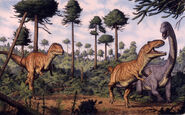| Giganotosaurus | |
|---|---|
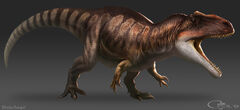
| |
| An artist's illustration of Giganotosaurus carolinii | |
| Scientific classification | |
| Kingdom: | Animalia |
| Phylum: | Chordata |
| clade: | Dinosauria |
| Order: | Saurischia |
| Suborder: | Theropoda |
| Family: | †Carcharodontosauridae |
| Tribe: | †Giganotosaurini |
| Genus: | †Giganotosaurus Coria &Selgado, 1995 |
| Species: | †G. carolinii |
| Binomial name | |
| †Giganotosaurus carolinii Coria & Selgado, 1995 | |
- Not to be confused with Gigantosaurus.
Giganotosaurus (gi·gan·o·to·saur·us) is one of the largest theropods, even larger than T. rex. Giganotosaurus lived in South America, and was thought to be capable of taking down the largest sauropod in its' home area, the Argentinosaurus, when it hunted in a pack.
Discovery
Giganotosaurus carolinii was named for Ruben Carolini, an amateur fossil hunter, who discovered the fossils in the deposits of the Rio Limay Formation of Patagonia, southern Argentina, in 1993. It was published by Rodolfo Coria and Leonardo Selgado in the journal Nature in 1995.

The holotype specimen's (MUCPv-Ch1) skeleton was about 70% complete and included the skull, pelvis, leg bones and most of the backbone. It is estimated about 6.8 tonnes (7.5 tons) in weight, 3.7 meters (12 feet) tall at the hip and 12.4 metres (39–46 ft) in length. A second specimen (MUCPv-95), was estimated at 6,5–8% larger. This larger Giganotosaurus specimen was estimated to represent an individual 13.2 m (43 ft) long that weighed 8.2 tonnes (9.0 tons) Scientists believe that it could have grew up to 14 meters. Giganotosaurus might have had one the longest known skull for a theropod dinosaur, with the holotype's skull estimated at 1.54 meters and the paratype skull estimated at 1.64 meters. Tyrannosaurus may have outweighed Giganotosaurus because of the extra muscle-mass, but Giganotosaurus was slightly longer. The most complete skeleton was housed at the Royal Ontario Museum until March 17, 2013. The Specimen (MUCPv-Ch1) is 80 percent complete and is only missing its arms and feet.
Paleobiology
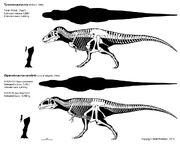
Giganotosaurus lived in Argentina alongside giant Sauropods like Limaysaurus and Andesaurus. Its close relatives from the same continent Tyrannotitan and Mapusaurus, and was also closely related to Carcharodontosaurus in Africa. It was the descendant of Allosaurus from the Jurassic period. It was the largest carcharodontosaurid and the second largest theropod of all time. It had a massive skull, a long tail for extra balance to help support its massive head, fairly long and strong arms with three clawed fingers, and powerful back legs with three sharp talons on their toes. Most people speculate, considering the length and musculature of its legs, that Giganotosaurus could run even 50.4 km/h, much faster than Olympic Sprinters and most of all Theropods including Rex. It had over 60 8-inch (19 cm.), blade-like teeth that could very easily pierce and rip through its unfortunate victims' flesh.

Giganotosaurus skull rebuilt
In 2005 Francois Terrier e.a. estimated that the bite force of Giganotosaurus was three times less than that of Tyrannosaurus and that the lower jaws were optimised for inflicting slicing wounds; the point of the mandibula was reinforced to this purpose with a "chin" and broadened to handle smaller prey.
Pointing Giganotosaurus killing method is killing by Slicing the flesh and Bleed the prey to Death. An Extremely Brutal but effective method.
Titanosaur fossils; belonging to Andesaurus and Limaysaurus have been recovered near the remains of Giganotosaurus, leading to speculation that these carnivores may have preyed on the giant herbivores. Fossils of the related carcharodontosaurid Mapusaurus grouped closely together may indicate pack hunting, a behavior that could possibly extend to Giganotosaurus itself.
In the Media
The original fossils of Giganotosaurus remain at the Carmen Funes Museum in Neuquen, Argentina, but replicas are common in other places, including the Australian Museum in Sydney. Despite having been discovered relatively recently, Giganotosaurus is already gaining a name for itself in popular culture. Giganotosaurus appears in the Walking with Dinosaurs special Land of Giants They are seen to hunt both independently and in packs, working together to bring down an Argentinosaurus. Giganotosaurus is also featured in the IMAX movie Dinosaurs: Giants of Patagonia where Dr. Rodolfo Coria shows the sites of major discoveries in Argentina.
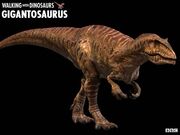
A Giganotosaurus also made an appearance in an episode of the ITV drama Primeval where it rampages at an airport.
Giganotosaurus is a recurring dinosaur in Dino Dan: Trek's Adventures.
Genetic material of Gigantosaurus in Jurassic World was in possession of InGen by the year 2014 and was used in the creation of the genetic hybrid Indominus rex.
It also appeared in Dino Crisis 2 at an exaggerated size and inaccurately shown to throw an adult Tyrannosaurus.

Primeval Giganotosaurus
Giganotosaurus makes an appearance in Turok, where it only appears in the Death Valley, although its actual species was not identified in the game. Although it is similar to Mama Scarface (a Tyrannosaurus in the game) in regards to behavior and sounds, it has noticeable differences, such as it does not have any scars on its face and has three fingered arms like its real counterpart. The Giganotosaurus in the game
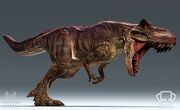
Turok Giganotosaurus
is shorter and leaner than Mama Scarface, but is possibly longer in terms of length.
Giganotosaurus appears in Prehistoric Monsters Revealed.

Giganotosaurus from Dinosaurs in the Beginning
One of the forms of the Predacon named Magmatron is a purple Giganotosaurus.
Giganotosaurus appears in the fifth movie of The Land Before Time.
Giganotosaurus appeared in the 2008 movie Journey to the Center of the Earth.
Giganotosaurus appeared in the Japanese animated film You Are Umasou, but only in a flashback scene.
Its' in, Warpath: Jurassic Park, Jurassic Park III: Park Builder, Jurassic Park: Builder and Jurassic World: The Game.
